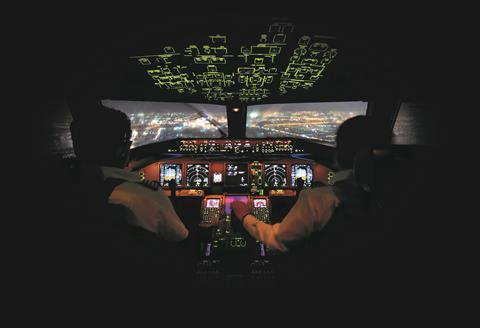Pilot unions have come out swinging against what they call a campaign by Airbus and other manufacturers to promote regulatory changes allowing a single pilot to be alone in commercial aircraft cockpits during certain flight phases.
“There is at least one aircraft manufacturer that is pressuring international aviation [authorities] to put profits first and introduce unacceptable levels of safety risk to commercial aviation,” International Federation of Air Line Pilots’ Associations (IFALP) president Jack Netskar said during a 4 May press briefing in Montreal.
Representatives from the European Cockpit Association (ECA) and US union Air Line Pilots Association (ALPA) also spoke.

ALPA president Jason Ambrosi says Airbus and the European Union Aviation Safety Agency (EASA) are involved in the “reduced-crew” push, which Netskar calls a “special-interest attempt to roll back… industry safety”.
The union chiefs mention involvement by the US Federal Aviation Administration and airline-standards group ICAO but are unspecific.
EASA confirms it “is considering” two types of reduced-pilot operations: “extended minimum-crew operations” and “single-pilot operations”. Airbus and business jet maker Dassault are “active in this area, and we are working with them”, EASA adds, noting it is consulting also with European states, pilot unions and ICAO.
Extended minimum-crew flights would involve “the possibility of having only one pilot at the controls during less-challenging phases of a flight – so, typically in cruise rather than at take-off and landing, while the other pilot(s) on board are resting”, EASA says.
Such an allowance would not change requirements that two pilots be in cockpits during take-off, landing and other “demanding operations”, it adds.
By contrast, single-pilot operations involve one pilot, alone in cockpits, during entire flights.
“Of these two, the concept that is being investigated more intensely” is extended minimum-crew operations, EASA says. It adds that single-pilot operations is not under consideration for passenger flights but has had some consideration for cargo flights.
“There is no firm timeline for the introduction of either type of operations,” it says. “The overriding concern is that any of these operations must be at least as safe as the current two-pilot operations. The manufacturers will need to demonstrate this to gain certification.”
Asked if it is involved in evaluating reduced-pilot flights, the FAA sent a statement that did not address the question.
The issue seems to have divided the aerospace and airline industries.
The labour bosses says airlines in North America oppose the reduced-pilot idea, but US airline trade group Airlines for America declines to comment.
Airbus says it has been studying, for purposes of boosting safety and efficiency, the idea of fewer pilots specifically during cruise flight.
Airbus stresses it is not evaluating reducing the number of pilots required to be aboard.
“For flights currently operated by two pilots, the crew would be able to take turns to rest during the cruise phase, with one pilot in the cockpit at all times. For longer flights operated by three or four pilots, extended minimum-crew operations will also be beneficial without eliminating the need for the number of required flight crew,” Airbus says. “Pilots will remain at the heart of operations.”
Dassault did not immediately responded to a request for comment.
ICAO says two “working papers” related to the topic were submitted at its last general assembly but that member states “didn’t agree on any related resolutions at that time”.
Boeing defers comment to aviation regulators but says “the reason the aviation system is as safe as it is today is because of what pilots do”.
During the 4 May briefing, the labour bosses vowed to oppose any such efforts, even amid automation advances. They view the campaign as leading to changes allowing flights now operated by three pilots to carry only two.
“There is no compromise,” Netskar says.
“That third pilot is what allows them to rotate through, to get the proper rest. Having one pilot in the flight deck is unacceptable at any time,” ALPA’s Ambrosi says.
ECA president Otjan de Bruijn says aircraft manufacturers are framing the effort “as a solution to” a shortage of pilots and as a means of combating pilot fatigue.
Airlines have been battling what they describe as a challenging shortage of pilots that, in the USA at least, has forced regional airlines to cut service to smaller communities, those airlines say.
In response, US regional airlines have been urging for commercial pilots to be allowed to fly until age 67 – today, they must step down at 65. The carriers have also pushed to ease a rule requiring new pilots to have, generally, more than 1,500h of total flight time before flying large passenger jets.
Story updated on 4 May to include comments from Boeing and from ICAO.











































